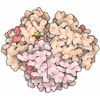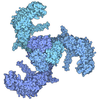+ Open data
Open data
- Basic information
Basic information
| Entry | Database: PDB / ID: 1nfi | ||||||
|---|---|---|---|---|---|---|---|
| Title | I-KAPPA-B-ALPHA/NF-KAPPA-B COMPLEX | ||||||
 Components Components |
| ||||||
 Keywords Keywords | COMPLEX (TRANSCRIPTION REG/ANK REPEAT) / COMPLEX (TRANSCRIPTION REGULATION-ANK REPEAT) / ANKYRIN REPEAT / COMPLEX (TRANSCRIPTION REG-ANK REPEAT) COMPLEX | ||||||
| Function / homology |  Function and homology information Function and homology informationnegative regulation of cholesterol transport / I-kappaB/NF-kappaB complex / negative regulation of vitamin D biosynthetic process / positive regulation of hyaluronan biosynthetic process / mammary gland involution / antibacterial innate immune response / negative regulation of myeloid cell differentiation / prolactin signaling pathway / cellular response to interleukin-17 / DEx/H-box helicases activate type I IFN and inflammatory cytokines production ...negative regulation of cholesterol transport / I-kappaB/NF-kappaB complex / negative regulation of vitamin D biosynthetic process / positive regulation of hyaluronan biosynthetic process / mammary gland involution / antibacterial innate immune response / negative regulation of myeloid cell differentiation / prolactin signaling pathway / cellular response to interleukin-17 / DEx/H-box helicases activate type I IFN and inflammatory cytokines production / NF-kappaB p50/p65 complex / toll-like receptor TLR6:TLR2 signaling pathway / IkBA variant leads to EDA-ID / positive regulation of Schwann cell differentiation / nucleotide-binding oligomerization domain containing 1 signaling pathway / response to cobalamin / cellular response to peptidoglycan / positive regulation of lipid storage / negative regulation of interleukin-12 production / ankyrin repeat binding / Regulated proteolysis of p75NTR / CLEC7A/inflammasome pathway / SUMOylation of immune response proteins / RIP-mediated NFkB activation via ZBP1 / Interleukin-1 processing / negative regulation of protein sumoylation / postsynapse to nucleus signaling pathway / nucleotide-binding oligomerization domain containing 2 signaling pathway / defense response to tumor cell / nuclear localization sequence binding / cellular response to interleukin-6 / positive regulation of macrophage derived foam cell differentiation / cellular response to dsRNA / actinin binding / response to UV-B / non-canonical NF-kappaB signal transduction / negative regulation of non-canonical NF-kappaB signal transduction / positive regulation of miRNA metabolic process / positive regulation of leukocyte adhesion to vascular endothelial cell / Regulation of NFE2L2 gene expression / interleukin-1-mediated signaling pathway / NF-kappaB complex / signal transduction involved in regulation of gene expression / vascular endothelial growth factor signaling pathway / toll-like receptor 4 signaling pathway / cellular response to hepatocyte growth factor stimulus / positive regulation of amyloid-beta formation / negative regulation of NF-kappaB transcription factor activity / negative regulation of protein import into nucleus / cellular response to cold / phosphate ion binding / positive regulation of T cell receptor signaling pathway / response to exogenous dsRNA / cellular response to lipoteichoic acid / response to muramyl dipeptide / TRAF6 mediated NF-kB activation / positive regulation of vascular endothelial growth factor production / Transcriptional Regulation by VENTX / cellular response to angiotensin / The NLRP3 inflammasome / general transcription initiation factor binding / negative regulation of macrophage derived foam cell differentiation / negative regulation of lipid storage / negative regulation of Notch signaling pathway / cellular response to interleukin-1 / response to cAMP / canonical NF-kappaB signal transduction / positive regulation of cholesterol efflux / hair follicle development / neuropeptide signaling pathway / NF-kappaB binding / positive regulation of transcription initiation by RNA polymerase II / response to amino acid / cellular defense response / Purinergic signaling in leishmaniasis infection / RNA polymerase II core promoter sequence-specific DNA binding / transcription regulator inhibitor activity / JNK cascade / Notch signaling pathway / response to muscle stretch / response to cytokine / positive regulation of interleukin-12 production / negative regulation of canonical NF-kappaB signal transduction / antiviral innate immune response / negative regulation of cytokine production involved in inflammatory response / peptide binding / CD209 (DC-SIGN) signaling / negative regulation of insulin receptor signaling pathway / NF-kB is activated and signals survival / response to interleukin-1 / protein sequestering activity / response to progesterone / negative regulation of miRNA transcription / lipopolysaccharide-mediated signaling pathway / MAP3K8 (TPL2)-dependent MAPK1/3 activation / negative regulation of angiogenesis / Turbulent (oscillatory, disturbed) flow shear stress activates signaling by PIEZO1 and integrins in endothelial cells / animal organ morphogenesis / response to ischemia / positive regulation of interleukin-1 beta production Similarity search - Function | ||||||
| Biological species |  Homo sapiens (human) Homo sapiens (human) | ||||||
| Method |  X-RAY DIFFRACTION / X-RAY DIFFRACTION /  SYNCHROTRON / SYNCHROTRON /  MIR / Resolution: 2.7 Å MIR / Resolution: 2.7 Å | ||||||
 Authors Authors | Jacobs, M.D. / Harrison, S.C. | ||||||
 Citation Citation |  Journal: Cell(Cambridge,Mass.) / Year: 1998 Journal: Cell(Cambridge,Mass.) / Year: 1998Title: Structure of an IkappaBalpha/NF-kappaB complex. Authors: Jacobs, M.D. / Harrison, S.C. | ||||||
| History |
|
- Structure visualization
Structure visualization
| Structure viewer | Molecule:  Molmil Molmil Jmol/JSmol Jmol/JSmol |
|---|
- Downloads & links
Downloads & links
- Download
Download
| PDBx/mmCIF format |  1nfi.cif.gz 1nfi.cif.gz | 249.9 KB | Display |  PDBx/mmCIF format PDBx/mmCIF format |
|---|---|---|---|---|
| PDB format |  pdb1nfi.ent.gz pdb1nfi.ent.gz | 200.4 KB | Display |  PDB format PDB format |
| PDBx/mmJSON format |  1nfi.json.gz 1nfi.json.gz | Tree view |  PDBx/mmJSON format PDBx/mmJSON format | |
| Others |  Other downloads Other downloads |
-Validation report
| Summary document |  1nfi_validation.pdf.gz 1nfi_validation.pdf.gz | 403.8 KB | Display |  wwPDB validaton report wwPDB validaton report |
|---|---|---|---|---|
| Full document |  1nfi_full_validation.pdf.gz 1nfi_full_validation.pdf.gz | 460 KB | Display | |
| Data in XML |  1nfi_validation.xml.gz 1nfi_validation.xml.gz | 32 KB | Display | |
| Data in CIF |  1nfi_validation.cif.gz 1nfi_validation.cif.gz | 47.5 KB | Display | |
| Arichive directory |  https://data.pdbj.org/pub/pdb/validation_reports/nf/1nfi https://data.pdbj.org/pub/pdb/validation_reports/nf/1nfi ftp://data.pdbj.org/pub/pdb/validation_reports/nf/1nfi ftp://data.pdbj.org/pub/pdb/validation_reports/nf/1nfi | HTTPS FTP |
-Related structure data
| Similar structure data |
|---|
- Links
Links
- Assembly
Assembly
| Deposited unit | 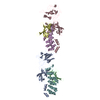
| ||||||||
|---|---|---|---|---|---|---|---|---|---|
| 1 | 
| ||||||||
| 2 | 
| ||||||||
| Unit cell |
| ||||||||
| Noncrystallographic symmetry (NCS) | NCS oper: (Code: given Matrix: (-1, 0.003, -0.001), Vector: |
- Components
Components
| #1: Protein | Mass: 34547.199 Da / Num. of mol.: 2 Source method: isolated from a genetically manipulated source Source: (gene. exp.)  Homo sapiens (human) / Production host: Homo sapiens (human) / Production host:  #2: Protein | Mass: 12442.117 Da / Num. of mol.: 2 Source method: isolated from a genetically manipulated source Source: (gene. exp.)  Homo sapiens (human) / Production host: Homo sapiens (human) / Production host:  #3: Protein | Mass: 23312.512 Da / Num. of mol.: 2 / Fragment: ANKYRIN Source method: isolated from a genetically manipulated source Source: (gene. exp.)  Homo sapiens (human) / Production host: Homo sapiens (human) / Production host:  #4: Water | ChemComp-HOH / | |
|---|
-Experimental details
-Experiment
| Experiment | Method:  X-RAY DIFFRACTION X-RAY DIFFRACTION |
|---|
- Sample preparation
Sample preparation
| Crystal | Density Matthews: 3.02 Å3/Da / Density % sol: 59 % | |||||||||||||||||||||||||||||||||||||||||||||
|---|---|---|---|---|---|---|---|---|---|---|---|---|---|---|---|---|---|---|---|---|---|---|---|---|---|---|---|---|---|---|---|---|---|---|---|---|---|---|---|---|---|---|---|---|---|---|
| Crystal grow | pH: 5 / Details: pH 5.0 | |||||||||||||||||||||||||||||||||||||||||||||
| Crystal grow | *PLUS Temperature: 4, 20 ℃ / Method: vapor diffusion, hanging drop | |||||||||||||||||||||||||||||||||||||||||||||
| Components of the solutions | *PLUS
|
-Data collection
| Diffraction | Mean temperature: 110 K |
|---|---|
| Diffraction source | Source:  SYNCHROTRON / Site: SYNCHROTRON / Site:  NSLS NSLS  / Beamline: X25 / Wavelength: 0.9879 / Beamline: X25 / Wavelength: 0.9879 |
| Detector | Type: BRANDEIS - B4 / Detector: CCD |
| Radiation | Monochromatic (M) / Laue (L): M / Scattering type: x-ray |
| Radiation wavelength | Wavelength: 0.9879 Å / Relative weight: 1 |
| Reflection | Resolution: 2.7→20 Å / Num. obs: 41990 / % possible obs: 92 % / Redundancy: 3.6 % / Biso Wilson estimate: 60.4 Å2 / Rsym value: 0.05 |
| Reflection | *PLUS Redundancy: 3.7 % / Rmerge(I) obs: 0.05 |
| Reflection shell | *PLUS % possible obs: 83 % / Rmerge(I) obs: 0.206 |
- Processing
Processing
| Software |
| ||||||||||||||||||||||||||||||||||||||||||||||||||||||||||||||||||||||||||||||||
|---|---|---|---|---|---|---|---|---|---|---|---|---|---|---|---|---|---|---|---|---|---|---|---|---|---|---|---|---|---|---|---|---|---|---|---|---|---|---|---|---|---|---|---|---|---|---|---|---|---|---|---|---|---|---|---|---|---|---|---|---|---|---|---|---|---|---|---|---|---|---|---|---|---|---|---|---|---|---|---|---|---|
| Refinement | Method to determine structure:  MIR / Resolution: 2.7→20 Å / Rfactor Rfree error: 0.006 / Data cutoff high rms absF: 1441954.76 / Isotropic thermal model: RESTRAINED / Cross valid method: THROUGHOUT / σ(F): 0 / Details: BULK SOLVENT MODEL USED MIR / Resolution: 2.7→20 Å / Rfactor Rfree error: 0.006 / Data cutoff high rms absF: 1441954.76 / Isotropic thermal model: RESTRAINED / Cross valid method: THROUGHOUT / σ(F): 0 / Details: BULK SOLVENT MODEL USED
| ||||||||||||||||||||||||||||||||||||||||||||||||||||||||||||||||||||||||||||||||
| Solvent computation | Solvent model: FLAT MODEL / Bsol: 37.18 Å2 / ksol: 0.343 e/Å3 | ||||||||||||||||||||||||||||||||||||||||||||||||||||||||||||||||||||||||||||||||
| Displacement parameters | Biso mean: 59.8 Å2
| ||||||||||||||||||||||||||||||||||||||||||||||||||||||||||||||||||||||||||||||||
| Refine analyze |
| ||||||||||||||||||||||||||||||||||||||||||||||||||||||||||||||||||||||||||||||||
| Refinement step | Cycle: LAST / Resolution: 2.7→20 Å
| ||||||||||||||||||||||||||||||||||||||||||||||||||||||||||||||||||||||||||||||||
| Refine LS restraints |
| ||||||||||||||||||||||||||||||||||||||||||||||||||||||||||||||||||||||||||||||||
| Refine LS restraints NCS | NCS model details: CONSTRAINTS | ||||||||||||||||||||||||||||||||||||||||||||||||||||||||||||||||||||||||||||||||
| LS refinement shell | Resolution: 2.7→2.8 Å / Rfactor Rfree error: 0.028 / Total num. of bins used: 10
| ||||||||||||||||||||||||||||||||||||||||||||||||||||||||||||||||||||||||||||||||
| Xplor file |
| ||||||||||||||||||||||||||||||||||||||||||||||||||||||||||||||||||||||||||||||||
| Software | *PLUS Name: CNS / Version: 0.5 / Classification: refinement | ||||||||||||||||||||||||||||||||||||||||||||||||||||||||||||||||||||||||||||||||
| Refinement | *PLUS Num. reflection obs: 39742 / Rfactor obs: 0.222 / Rfactor Rfree: 0.315 | ||||||||||||||||||||||||||||||||||||||||||||||||||||||||||||||||||||||||||||||||
| Solvent computation | *PLUS | ||||||||||||||||||||||||||||||||||||||||||||||||||||||||||||||||||||||||||||||||
| Displacement parameters | *PLUS | ||||||||||||||||||||||||||||||||||||||||||||||||||||||||||||||||||||||||||||||||
| Refine LS restraints | *PLUS
| ||||||||||||||||||||||||||||||||||||||||||||||||||||||||||||||||||||||||||||||||
| LS refinement shell | *PLUS Rfactor obs: 0.315 |
 Movie
Movie Controller
Controller



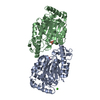




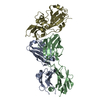

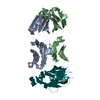
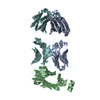

 PDBj
PDBj
















